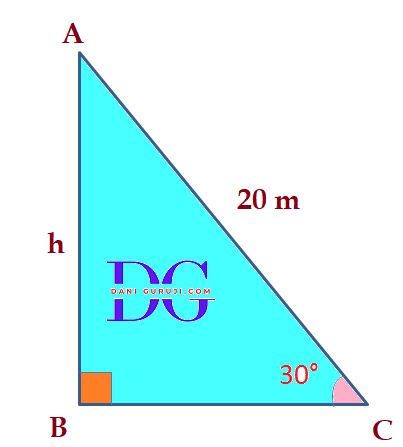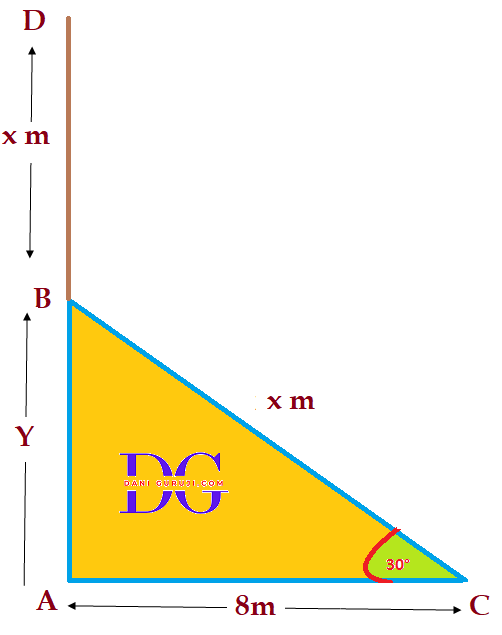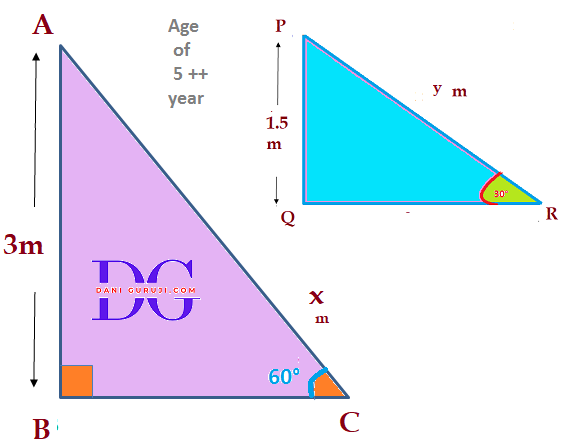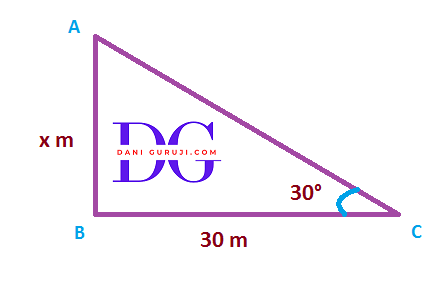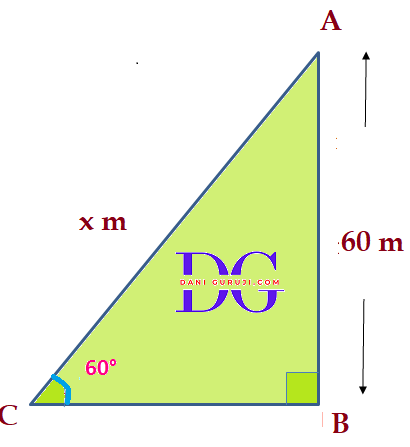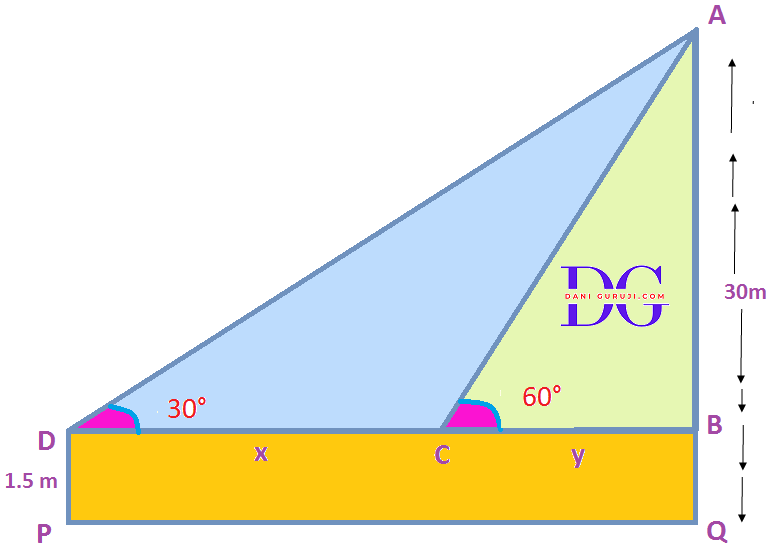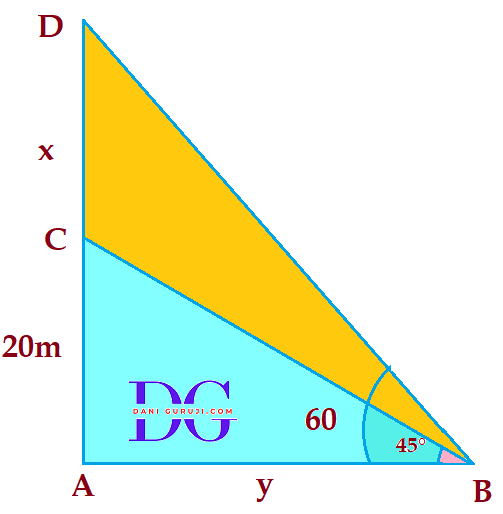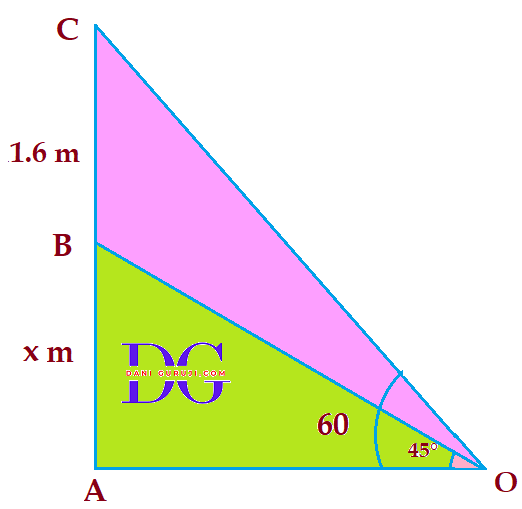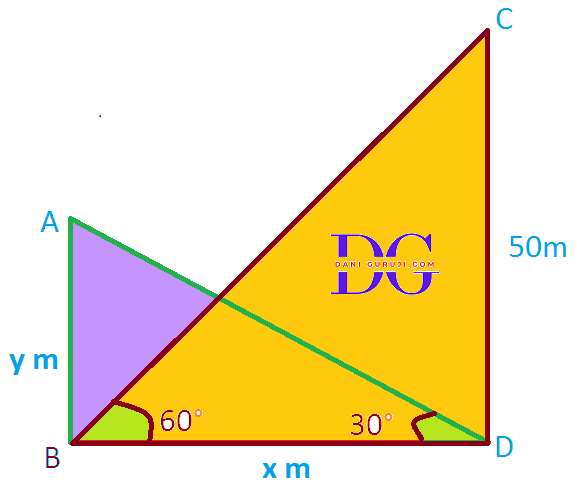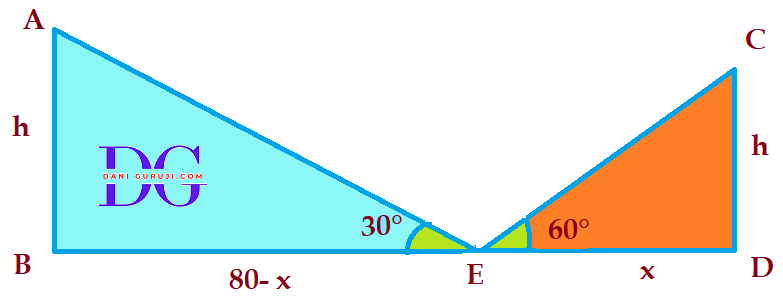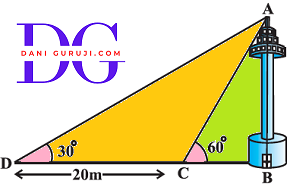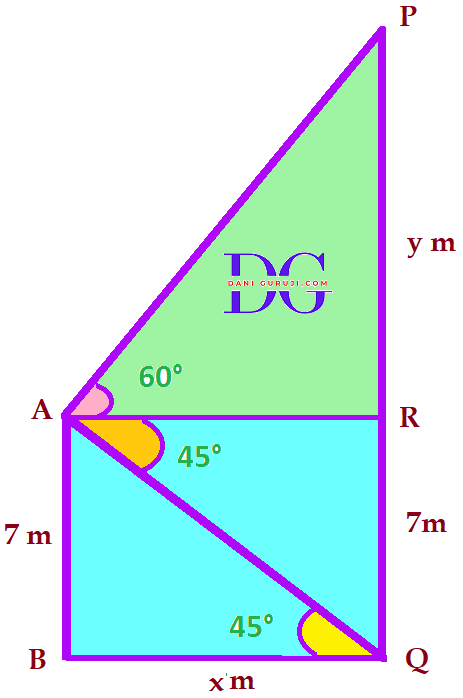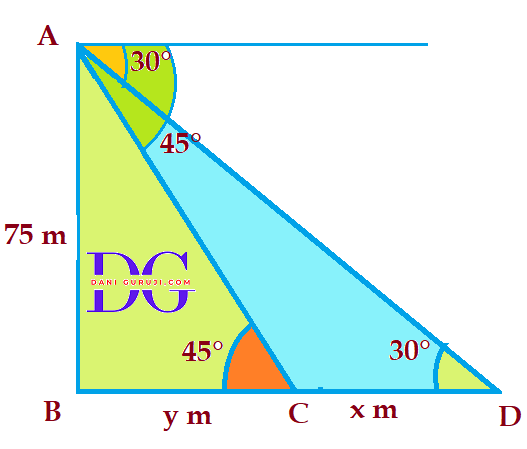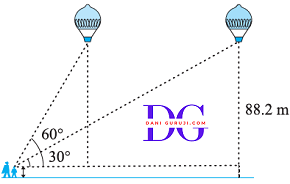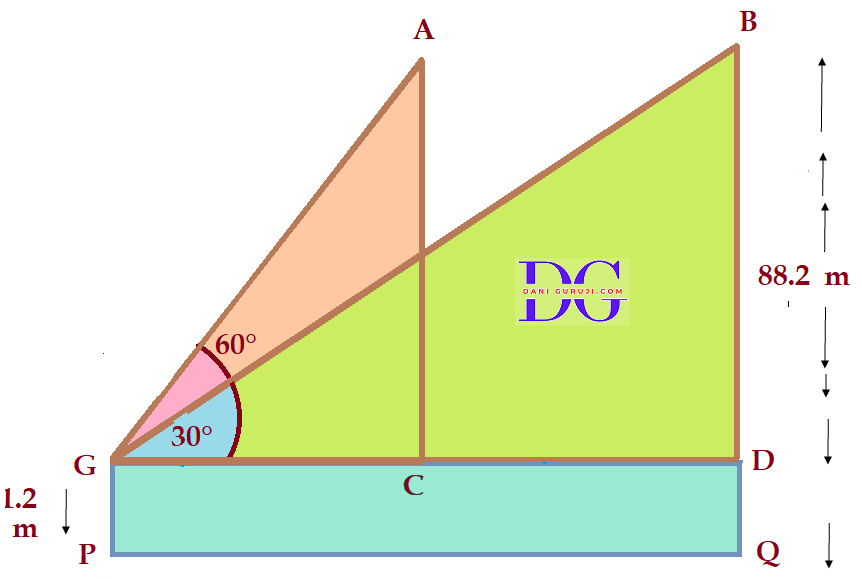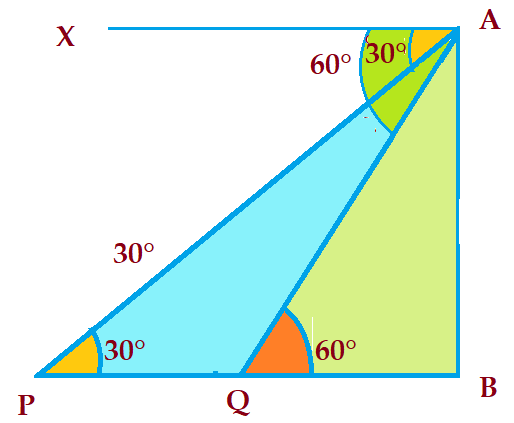A circus artist is climbing a 20 m long rope, which is tightly stretched and tied from the top of a vertical pole to the ground. Find the height of the pole, if the angle made by the rope with the ground level is 30° (see Fig.)
Solution :
Let the height of the pole is AB = ‘ h’ meter
and AC is the length of rope tied from the top of a vertical pole to the ground AC = 20 m
To find the height of the pole, we use the sine trigonometric ratio, which relates the angle to the lengths of the opposite side and the hypotenuse:
In Right Angle ΔABC
According to the question , $\angle $ B =90°
$$ sin θ = {Perpendicular \over Hypotenuse} = {AB \over AC }$$
Here, Angle of elevation, $\angle $ ACB = 30°
$$ ∴ Sin 30° = {AB \over AC } $$
$$ ⇒ {1 \over 2 } = {h \over 20 } $$
After cross multiplication
$$ ⇒ {20 \over 2 } = h $$
$$ ⇒ h = 10 $$
Therefore, the height of the pole is 10 m.
A tree breaks due to storm and the broken part bends so that the top of the tree touches the ground making an angle 30° with it. The distance between the foot of the tree to the point where the top touches the ground is 8 m. Find the height of the tree.
Solution :
Suppose AD is a tree and due to storm, it was broken into two parts. The BD is the broken height of the tree which touches the ground at C.
Let the height of the tree be AD = h m
Broken part of the tree be BC = x
height of the tree remaining is AB = Y
GIven that, The distance from the base of the tree to where the top touches the ground is 8 m = AC
According to the question ,
The angle the top of the tree makes with the ground is , $\angle $ ACB = 30°
In Right Angle ΔABC
In this case, the opposite side is the height of the unbroken part of the tree, and the adjacent side is the distance from the base of the tree to the point where the top touches the ground .
$$ tan 30° = {AB \over AC }$$
We know that tan 30° = $ {1 \over \sqrt{3}} $
$$ ⇒ {1 \over \sqrt{3}} = {y \over 8 }$$
$$ ⇒ y = {8 \over \sqrt{3} }$$
So, the value of y = $ {8 \over \sqrt{3} }$
Similarly
$$ cos 30° = {AC \over BC }$$
$$ ⇒ {\sqrt{3} \over 2} = {8 \over x }$$
$$ ⇒ x = {16 \over \sqrt{3} }$$
Total height = unbroken height + broken part length
AD = h = x + y
$$ ⇒ {16 \over \sqrt{3} } + {8 \over \sqrt{3} } $$
$$ ⇒ h = {24 \over \sqrt{3} } $$
$$ ⇒ h = { 8 × 3 \over \sqrt{3} } $$
$$ ⇒ AD = h = {8 \sqrt{3} } $$
Therefore, the height of the tree is $ {8 \sqrt{3} } $ m.
A contractor plans to install two slides for the children to play in a park. For the children below the age of 5 years, she prefers to have a slide whose top is at a height of 1.5 m, and is inclined at an angle of 30° to the ground, where as for elder children, she wants to have a steep slide at a height of 3m, and inclined at an angle of 60° to the ground. What should be the length of the slide in each case?
Solution :
(i) For Elder Children ( 5++ years)
Let the height of the slide is the side opposite the angle, which is AB = 3 meter
The length of the slide is the hypotenuse = AC = 'x' m
In Right Angle ΔABC , $\angle $ B = 90°
$$ sin θ = {AB \over AC }$$
Here, Angle of elevation, $\angle $ ACB = 60°
$$ ∴ Sin 60° = {AB \over AC } $$
We know that Sin 60° = $ {\sqrt{3} \over 2 } $
$$ ⇒ {\sqrt{3} \over 2 } = {3 \over x } $$
After cross multiplication
$$ ⇒ x = { 6 \over \sqrt{3} } $$
$$ ⇒ x = { 2 \sqrt{3} } $$
(ii) Younger Children (Below 5 years)
Let the height of the slide is the side opposite the angle, which is PQ = 1.5 meter.
The length of the slide is the hypotenuse = PR = 'y' m
In Right Angle ΔPQR , $\angle $ Q = 90°
$$ sin θ = {PQ \over PR }$$
Here, The angle of inclination is, $\angle $ PRQ = 30°
$$ ∴ Sin 30° = {PQ \over PR } $$
We know that Sin 30° = $ {1 \over 2 } $
$$ ⇒ {1 \over 2 } = {1.5 \over y } $$
After cross multiplication
$$ ⇒ y = { 3 \over 1 } $$
$$ ⇒ y = 3 $$
Therefore, Length of slide for children below 5 years is 3 m and length of slide for elder children is ${ 2 \sqrt{3} } $ m
The angle of elevation of the top of a tower from a point on the ground, which is 30 m away from the foot of the tower, is 30°. Find the height of the tower.
Solution :
Let the height of the tower is AB = x meter
Distance from the foot of the tower to a point , This is the side adjacent to the angle of elevation, given as 30 m = BC.
In Right Angle ΔABC , $\angle $ B =90°
$$ tan θ = {AB \over BC }$$
Here, Angle of elevation, The angle between the ground and the line of sight to the top of the tower, given as, $\angle $ ACB = 30°
$$ tan 30° = {AB \over BC }$$
$$ ⇒ {1 \over \sqrt{3}} = {x \over 30 }$$
We know that tan 30° = $ {1 \over \sqrt{3}} $
After cross multiplication, we get
$$ ⇒ x = {30 \over \sqrt{3}}$$
$$ ⇒ x = {10 × 3 \over \sqrt{3}}$$
$$ ⇒ x = {10 × \sqrt{3} × \sqrt{3} \over \sqrt{3}}$$
$$ ⇒ x = {10 × \sqrt{3} }$$
Therefore, the height of the tower is $ {10 \sqrt{3} } $ m.
A kite is flying at a height of 60 m above the ground. The string attached to the kite is temporarily tied to a point on the ground. The inclination of the string with the ground is 60°. Find the length of the string, assuming that there is no slack in the string.
Solution :
Let A be the temporarily position of the kite of which string is tied to to a point C on ground .
The height of the kite (60 m) is the side opposite the angle of inclination.
The angle of inclination of the string with the ground is $\angle $ ACB = 60° , Where B is point on the ground just below A. Therefore , AB = 60 m.
In Right Angle ΔABC , $\angle $ B =90°
To find the length of the string, we can use the sine trigonometric ratio, which relates the opposite side and the hypotenus
$$ Sin θ = {AB \over AC }$$
Here, Angle of elevation, $\angle $ ACB = 60°
$$ ∴ Sin 60° = {AB \over AC } $$
We know that Sin 60° = ${\sqrt{3} \over 2 } $
$$ ⇒ {\sqrt{3} \over 2 } = {60 \over x } $$
After cross multiplication, we get
$$ ⇒ x = {120 \over \sqrt{3}}$$
$$ ⇒ x = {40 × 3 \over \sqrt{3}}$$
$$ ⇒ x = {40 × \sqrt{3} × \sqrt{3} \over \sqrt{3}}$$
$$ ⇒ x = {40 × \sqrt{3} }$$
Therefore, the length of the string is $ {40 \sqrt{3} } $ m.
A 1.5 m tall boy is standing at some distance from a 30 m tall building. The angle of elevation from his eyes to the top of the building increases from 30° to 60° as he walks towards the building. Find the distance he walked towards the building.
Solution :
Let, boy DP is standing at a point P in the front of a building AQ.
The height of the tallboy DP is 1.5 m and the height of the building AQ is 30 m.
In this case the angle of elevation from the top of the building is 30° . Let DCB be the horizontal eye sight .
When that boy walks towards the building finds increased angle of 60° at point C.
Height from the boy's eye level to the top of the building,
It can be observed that
( AQ − BQ ) = AB = ( 30m − 1.5m) = 28.5m.
We have two triangles, both with a vertical side of 28.5 m
(1) Triangle ABD: Formed when the angle of elevation is 30°
According to question,In Right Angle Δ ABD,
$$ tan θ = {AB \over BD }$$
Here, Angle of elevation, $\angle $ ADB = 30°
$$ ⇒ tan 30° = {28.5 \over BD }$$
We know that tan 30° = $ {1 \over \sqrt{3}} $
$$ ⇒ {1 \over \sqrt{3}} = {28.5 \over BD }$$
After cross multiplication, we get
$$ ⇒ BD = ({28.5 × \sqrt{3} }) ........(i)$$
(2) Triangle ABC: Formed when the angle of elevation is 60°
Now, In Right Angle Δ ABC
$$ tan θ = {AB \over BC }$$
Here, Angle of elevation, $\angle $ ACB = 60°
$$ ∴ tan 60° = {AB \over BC } $$
We know that tan 60° = $ {\sqrt{3} } $
$$ ⇒ {\sqrt{3} } = {28.5 \over BC } $$
After cross multiplication, we get
$$ ⇒ BC = {28.5 \over \sqrt{3}}$$
Now, CD = BD – BC.
$$ ⇒ CD = ({28.5 × \sqrt{3} })- ({28.5 \over \sqrt{3}}) $$
$$ ⇒ CD = {({28.5 ×3 - 28.5}) \over \sqrt{3} } $$
$$ ⇒ CD = {28.5 ×({3 - 1}) \over \sqrt{3} } $$
$$ ⇒ CD = {28.5 ×({2}) \over \sqrt{3} } $$
$$ ⇒ CD = {57 \over \sqrt{3} } $$
$$ ⇒ CD = {19 ×3 \over \sqrt{3} } $$
$$ ⇒ CD = {19 ×\sqrt{3} } $$
So, distance walked by the boy towards the building =BD – BC = $ {19 \sqrt{3}}m $
From a point on the ground, the angles of elevation of the bottom and the top of a transmission tower fixed at the top of a 20 m high building are 45° and 60° respectively. Find the height of the tower.
Solution :
Let DC be the height of tower DC = x m and AC is the height of building AC = 20 m, and AB is the distance between the building and the observer point (B).
And angle of elevation from top point D of the transmission tower to a point of ground (B) is 60° and And angle of elevation from the bottom of the tower C at point B on the ground is 45°
We have two triangles, both with a vertical side of 'y' m
(1) Triangle ABC: Formed when the angle of elevation is 45°
According to question,In Right Angle Δ ABC,
$$ tan θ = {AC \over AB }$$
Here, Angle of elevation, $\angle $ ABC = 45°
$$ ⇒ tan 45° = {20 \over AB }$$
( We know that tan 45° = $ {1 } $)
$$ ⇒ 1 = {20 \over AB }$$
After cross multiplication, we get
$$ ⇒ AB = 20 m $$
The distance from the point on the ground to the base of the building is 20 m.
(2) Triangle ABD: Formed when the angle of elevation is 60°
$$ tan θ = {AD \over AB }$$
Here, Angle of elevation, $\angle $ ABD = 60°
$$ ∴ tan 60° = {AD \over AB } $$
We know that tan 60° = $ {\sqrt{3} } $
$$ ⇒ {\sqrt{3} } = {AD \over 20 } $$
(AB = 20m as calculated)
After cross multiplication, we get
$$ ⇒ AD = {20×\sqrt{3}}$$
the total height of the structure (building + tower) = $ {20×\sqrt{3}}$
Now, The height of the tower is the total height minus the height of the building.
CD = AD – AC.(As given in question, the height of the building = AC = 20m)
$$ ⇒ CD = ({20×\sqrt{3}})- (20) $$
$$ ⇒ CD = {20 ×(\sqrt{3} - 1) } $$
$$ ⇒ CD = {20 ×(1.732 - 1) } $$
$$ ⇒ CD = {20 ×(0.732 ) } $$
$$ ⇒ CD = 14.64 m $$
So, height of the given tower is 14.64 m
A statue, 1.6 m tall, stands on the top of a pedestal. From a point on the ground, the angle of elevation of the top of the statue is 60° and from the same point the angle of elevation of the top of the pedestal is 45°. Find the height of the pedestal.
Solution :
Let AB be the height of pedestal AB = x m and BC is the height of statue BC = 1.6 m, and AO is the distance between the pedestal and the observer point on the ground (O).
And angle of elevation from top point C of the statue to a point of ground (O) is 60° and And angle of elevation from the top point B of the pedestal at point O on the ground is 45° respectively.
We have two triangles,
(1) Triangle AOB: Formed when the angle of elevation is 45°
According to question,In Right Angle Δ AOB,
$$ tan θ = {AB \over AO }$$
Here, Angle of elevation, $\angle $ AOB = 45°
$$ ⇒ tan 45° = {x \over AO }$$
( We know that tan 45° = $ {1 } $)
$$ ⇒ 1 = {x \over AO }$$
After cross multiplication, we get
$$ ⇒ AO = x $$
This tells us that the height of the pedestal is equal to the distance from the point on the ground.
(2) Triangle AOC: Formed when the angle of elevation is 60°
$$ tan θ = {AC \over AO }$$
Here, Angle of elevation, $\angle $ AOC = 60°
$$ ∴ tan 60° = {AC \over AO }$$
We know that tan 60° = $ {\sqrt{3} } $
$$ ⇒ {\sqrt{3} } = {{x + 1.6} \over x } $$
( AO = x meter as calculated)
After cross multiplication, we get
$$ ⇒ x \sqrt{3} = {{x + 1.6}}$$
$$ ⇒ (x \sqrt{3}) - x = 1.6 $$
$$ ⇒ x ×( \sqrt{3} - 1 ) = 1.6 $$
( Using the approximate value $ {( \sqrt{3} = 1.732 })$
$$ ⇒ x ×(1.732 - 1) = 1.6 $$
$$ ⇒ x ×(0.732 ) = 1.6 $$
$$ ⇒ x = {1.6 \over (0.732 )}$$
$$ ⇒ x = 2.19 meter $$
So, height of the given pedestal is 2.19 meter .
The angle of elevation of the top of a building from the foot of the tower is 30° and the angle of elevation of the top of the tower from the foot of the building is 60°. If the tower is 50 m high, find the height of the building.
Solution :
Let AB be the height of building AB = y m and CD is the height of tower CD = 50 m.
The angle of elevation of the top of the building A from the foot of the tower D is equal to 30° and the angle of elevation of the tower from the foot of the building B is equal to 60° respectively.
This problem involves two right-angled triangles with a common base (the distance between the building and the tower). Let's denote the distance between the two structures as = BD = x m.
(1) Triangle BCD: Formed when the angle of elevation is 60°
According to question,In Right Angle Δ BCD,
$$ cot θ = {BD \over CD }$$
Here, Angle of elevation, $\angle $ CBD = 60°
$$ ⇒ cot 60° = {x \over 50 }$$
We know that cot 60° = $ {1 \over \sqrt{3}} $
$$ ⇒ {1 \over \sqrt{3}} = {x \over 50 }$$
After cross multiplication, we get
$$ ⇒ x = {50 \over \sqrt{3}} $$
(1) Triangle ABD: Formed when the angle of elevation is 30°
Now, In Right Angle Δ ABD
$$ tan θ = {AB \over BD }$$
Here, Angle of elevation, $\angle $ ADB = 30°
$$ ∴ tan 30° = {AB \over BD } $$
We know that tan 30° = $ {1 \over \sqrt{3}} $
$$ ⇒ {1 \over \sqrt{3}} = {y \over x } $$
After cross multiplication, we get
$$ ⇒ {x \over \sqrt{3}} = {y } $$
$$ ⇒ y = { {50 \over \sqrt{3}} \over \sqrt{3}} $$
$$ ⇒ y = { {50 \over \sqrt{3}} × {1 \over \sqrt{3}}} $$
$$ ⇒ y = { 50 \over 3} $$
$$ ⇒ y = 16 ( {2 \over 3 })meter$$
So, height of the given building is $ 16 ( {2 \over 3 })meters $.
Two poles of equal heights are standing opposite each other on either side of the road, which is 80 m wide. From a point between them on the road, the angles of elevation of the top of the poles are 60° and 30°, respectively. Find the height of the poles and the distances of the point from the poles.
Solution :
The width of the road is 80 meters. The point on the road is E. Let's label the poles as AB and CD. The point E is between them.
Let's denote the height of the two poles as h meters, AB = CD = h meter.
Let the distance from point E to pole AB, BE = (80-x) meter. The distance from point E to pole CD will then, ED = x meters.
Let, At point E between road the angle of elevation of the top of the pole AB =30° and the angle of elevation of the pole CD =60°
In Right Angle Δ ABE
$$ tan θ = {AB \over BE}$$
Here, Angle of elevation, $\angle $ AEB = 30°
$$ ⇒ tan 30° = {h \over {(80-x)} }$$
$$ ⇒ {1 \over \sqrt{3}} = {h \over {(80-x)} }$$
After cross multiplication, we get
$$ ⇒ h = [ {{(80-x)} \over \sqrt{3}}] ........(i) $$
Now, In Right Angle Δ CDE
$$ tan θ = {CD \over ED }$$
Here, Angle of elevation, $\angle $ CED = 60°
$$ ∴ tan 60° = {CD \over ED } $$
$$ ⇒ { \sqrt{3}} = { h \over x } $$
After cross multiplication, we get
$$ ⇒ h = [{x \sqrt{3}}] ........(ii) $$
Now, from equation (i) and (ii), we get
$$ ⇒ {{(80-x)} \over \sqrt{3}} = {x \sqrt{3}} $$
$$ ⇒ {(80-x)} = {3x } $$
$$ ⇒ {80} = {4x } $$
$$ ⇒ x = 20 m $$
Now that we have the value of x, we can find the height of the poles using Equation (ii):
$$ ⇒ h = 20\sqrt{3}m $$
The distances of the point from the poles are:
Distance from the second pole (CD) = x = 20 meters
Distance from the first pole (AB) = 80−x = 80−20 = 60 meters
So, the height of the poles is $ ⇒ h = 20\sqrt{3} $ meters, and the distances of the point from the poles are 60 meters and 20 meters.
A TV tower stands vertically on a bank of a canal. From a point on the other bank directly opposite the tower, the angle of elevation of the top of the tower is 60°. From another point 20 m away from this point on the line joining this point, to the foot of the tower, the angle of elevation of the top of the tower is 30° (see Fig. ). Find the height of the tower and the width of the canal.
Solution :
Suppose the h is the height of the tower AB and width of the canal be ‘x’ metres, so AB = h m and BC = x m .
It is given that, the width of CD is 20 m,
According to question,In Right Angle Δ ABD,
( From the second point, which is 20 m away from the first point, the angle of elevation is 30°. This forms a larger right-angled triangle. The opposite side is still the height of the tower (h), but the adjacent side is now the sum of the canal's width and the additional distance, so it's (x + 20).)
$$ tan θ = {AB \over BD }$$
Here, Angle of elevation, $\angle $ ADB = 30°
$$ ⇒ tan 30 = {h \over {(20 + x)} }$$
$$ ⇒ {1 \over \sqrt{3}} = {h \over {(20 + x)} }$$
After cross multiplication, we get
$$ ⇒ h = [{{(20 + x)} \over \sqrt{3} }] ........(i)$$
Now, In Right Angle Δ ABC
( From the first point, which is directly opposite the tower on the other bank of the canal, the angle of elevation is 60°. This forms a right-angled triangle where the opposite side is the height of the tower (h) and the adjacent side is the width of the canal (x). )
$$ tan θ = {AB \over BC }$$
Here, Angle of elevation, $\angle $ ACB = 60°
$$ ∴ tan 60° = {AB \over BC } $$
$$ ⇒ {\sqrt{3} } = {h \over x } $$
After cross multiplication, we get
$$ ⇒ h = [{ \sqrt{3}x}] ........(ii) $$
On equating eq (i) and (ii) we get
$$ ⇒ {{(20 + x)} \over \sqrt{3} } = { \sqrt{3}x} $$
$$ ⇒ {(20 + x)} = { \sqrt{3}x} × { \sqrt{3}}$$
$$ ⇒ 20 + x = 3x $$
$$ ⇒ 2x = 20 $$
$$ ⇒ x = 10 $$
The width of the canal is x = 10 meters.
Put x = 10 in equation (ii)
$$ ⇒ h = { \sqrt{3}}× 10 $$
$$ ⇒ h = 10 { \sqrt{3}}m$$
Hence, height of the tower is $ {10 \sqrt{3}}m $ and width of the canal is 10 m.
From the top of a 7 m high building, the angle of elevation of the top of a cable tower is 60° and the angle of depression of its foot is 45°. Determine the height of the tower.
Solution :
Let AB be a building and PQ be a cable tower. The height of the building is 7 m , AB = 7 m. and the height of the cable tower be PQ = (7 + y) m.
Angle of elevation from the top of the tower to the top of the building,$\angle $ PAR = 60°
And, angle of depression of the foot of the cable tower to the top of the building, $\angle $ RAQ = 45° .
Since AB || RQ thus $\angle $ RAQ = $\angle $ AQB = 45°
Now, AB = RQ = 7m . Let BQ = AR = x meter, and PR = y meter.
In Right Angle Δ ABQ
$$ tan θ = {AB \over BQ}$$
Here, Angle of elevation,$\angle $ AQB = 45°
$$ ⇒ tan 45° = {7 \over x} $$
$$ ⇒ 1 = {7 \over x} $$
After cross multiplication, we get
$$ ⇒ ( x = 7) ........(i) $$
Now, In Right Angle ΔPRA
$$ tan θ = {PR \over AR }$$
Here, Angle of elevation, $\angle $ PAR = 60°
$$ ∴ tan 60° = {PR \over AR } $$
$$ ⇒ { \sqrt{3}} = { y \over x } $$
After cross multiplication, we get
$$ ⇒ y = {x \sqrt{3}} $$
Now, from equation (i) , we get
$$ ⇒ y = {7 \sqrt{3}} $$
∴ the height of the tower = PQ = (7 + y) m $$ ⇒ 7 + ({7 \sqrt{3}}) $$
$$ ⇒PQ = {7 (1 + \sqrt{3})}m $$
Thus, the total height of the tower equal to $ {7 (1 + \sqrt{3})} $ meters .
As observed from the top of a 75 m high lighthouse from the sea-level, the angles of depression of two ships are 30° and 45°. If one ship is exactly behind the other on the same side of the lighthouse, find the distance between the two ships.
Solution :
Let A be the top of the lighthouse, B be the base of the lighthouse, and C and D be the positions of the two ships. The height of the lighthouse, AB, is 75 m.
The angles of depression from the top of the lighthouse are equal to the angles of elevation from the ships due to alternate interior angles.
The angle of elevation of the closer ship $\angle $ ACB = 45° and the angle of elevation of the farther ship $\angle $ ADB = 30° respectively .
Let , distance between two ships be DC = x meter , and BC = y meter.
In Right Angle Δ ADB
$$ tan θ = {AB \over BD}$$
Here, Angle of elevation, $\angle $ ADB = 30°
$$ ⇒ tan 30° = {75 \over {(x+y)}} $$
$$ ⇒ {1 \over \sqrt{3}} = {75 \over {(x+y)}} $$
After cross multiplication, we get
$$ ⇒ [(x+y) = 75 \sqrt{3}] ........(i) $$
The distance from the lighthouse to the farther ship is BD = $ { 75 \sqrt{3}} $
Now, In Right Angle ΔACB
$$ tan θ = {AB \over BC}$$
Here, Angle of elevation, $\angle $ ACB = 45°
$$ ∴ tan 45° = {AB \over BC} $$
$$ ⇒ 1 = { 75 \over y } $$
After cross multiplication, we get
$$ ⇒ y = 75 $$
The distance from the lighthouse to the closer ship is BC = 75 m.
Distance between ships = BD − BC
⇒ Distance between ships = $ 75 \sqrt{3} - 75 $
⇒ Distance between ships =$ { 75 ( \sqrt{3} - 1)} $
Hence, The distance between the two ships is $ { 75 ( \sqrt{3} - 1)} $ meters .
A 1.2 m tall girl spots a balloon moving with the wind in a horizontal line at a height of 88.2 m from the ground. The angle of elevation of the balloon from the eyes of the girl at any instant is 60°. After some time, the angle of elevation reduces to 30° (see Fig. ), Find the distance travelled by the balloon during the interval.
Solution :
Let A and B be two positions of the balloon and G be a point of observation.
It is given that, height of the balloon from ground, BQ= 88.2 m,
Height of the girl GP = DQ = 1.2 m
∴ AC = BD = BQ – DQ = 88.2 m – 1.2 m = 87 m
In Right Angle Δ AGC
$$ tan θ = {AC \over GC }$$
Here, Angle of elevation, $\angle $ AGC = 60°
$$ ⇒ tan 60° = {87 \over {(GC)} }$$
$$ ⇒ { \sqrt{3}} = {87 \over {(GC)}}$$
After cross multiplication, we get
$$ ⇒ GC = [{87 \over {\sqrt{3}}}] ........(i)$$
Now, In Right Angle Δ BGD
$$ tan θ = {BD \over GD }$$
Here, Angle of elevation,$\angle $ BGD = 30°
$$ ∴ tan 30° = {BD \over GD } $$
$$ ⇒ {1 \over \sqrt{3}} = {87 \over GD} $$
After cross multiplication, we get
$$ ⇒ GD = [{ 87\sqrt{3}}] ........(ii) $$
Balloon travels CD = GD – GC
After substituting the value of GD ,GC from equation (i) and (ii), we get
$$ ⇒ CD = { 87\sqrt{3}} - { 87 \over {\sqrt{3}}}$$
$$ ⇒ CD = {{ 87\sqrt{3}× \sqrt{3} - 87 } \over{\sqrt{3}}}$$
$$ ⇒ CD = {{ 87 × 3 - 87 } \over{\sqrt{3}}}$$
$$ ⇒ CD = {{ 87 (3 - 1) } \over{\sqrt{3}}}$$
$$ ⇒ CD = {{ 87 × 2 } \over{\sqrt{3}}}$$
$$ ⇒ CD = {{ 174 } \over{\sqrt{3}}}$$
$$ ⇒ CD = {{ 58 × 3 } \over{\sqrt{3}}}$$
$$ ⇒ CD = {{ 58 × \sqrt{3}× \sqrt{3} } \over{\sqrt{3}}}$$
$$ ⇒ CD = {58 × \sqrt{3} }$$
Hence, Distance travelled by balloon = $ {58 × \sqrt{3} } $ meters.
A straight highway leads to the foot of a tower. A man standing at the top of the tower observes a cart at an angle of depression of 30°, which approaching the foot of the tower with a uniform speed. Six seconds later, the angle of depression of the car is found to be 60°. Find the time taken by the car to reach the foot of the tower from this point.
Solution :
Let AB be the tower on the top of which a man is standing and finds the angle of depression to position P of the running car as 30°
After 6 seconds, angle is found 60° at point Q
According to question,When car is at point P,
In Right Angle Δ ABP,
$$ tan θ = {AB \over BP }$$
Here, Angle of elevation, $\angle $ APB = 30°
$$ ⇒ tan 30° = {AB \over BP }$$
$$ ⇒ {1 \over \sqrt{3}} = {AB \over BP }$$
After cross multiplication, we get
$$ ⇒ AB = [{BP \over \sqrt{3} }] ........(i)$$
Now, When car is at point Q,In Right Angle Δ ABQ
$$ tan θ = {AB \over BQ }$$
Here, Angle of elevation, $\angle $ AQB = 60°
$$ ∴ tan 60° = {AB \over BQ } $$
$$ ⇒ {\sqrt{3} } = {AB \over BQ } $$
After cross multiplication, we get
$$ ⇒ AB = [ { \sqrt{3}}BQ] ........(ii) $$
On equating eq (i) and (ii) we get
$$ ⇒ {BP \over \sqrt{3} } = { \sqrt{3}BQ } $$
$$ ⇒ {BP } = { \sqrt{3}BQ } × { \sqrt{3}}$$
$$ ⇒ BP = 3 BQ $$
( ∵ BP = BQ + PQ From Fig )
$$ BQ + PQ = 3BQ $$
$$ PQ = 3BQ – BQ $$
$$ PQ = 2 BQ $$
$$ BQ = 1/2 PQ $$
According to question,
Time taken by the car to travel distance BP = 6 seconds , and the car is moving with uniform speed.
So, a distance of BQ meters will be covered in
BQ = 1/2 × PQ = 1/2 × 6 = 3 seconds
Hence, car will take 3 seconds to reach the foot of tower.
Syllabus for class 10
Advanced courses and exam preparation.
Previous Year Paper
Advanced courses and exam preparation.
Mock Test
Explore programming, data science, and AI.
